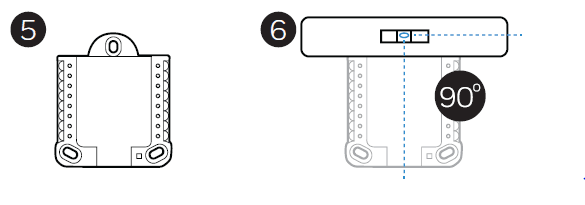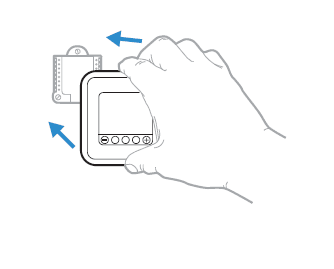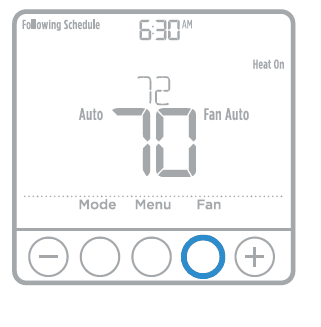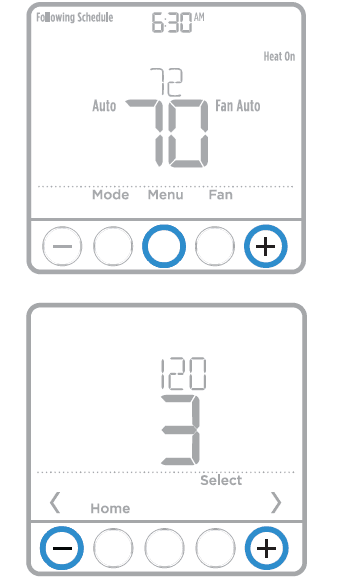
Honeywell T6 Pro Programmable Thermostat
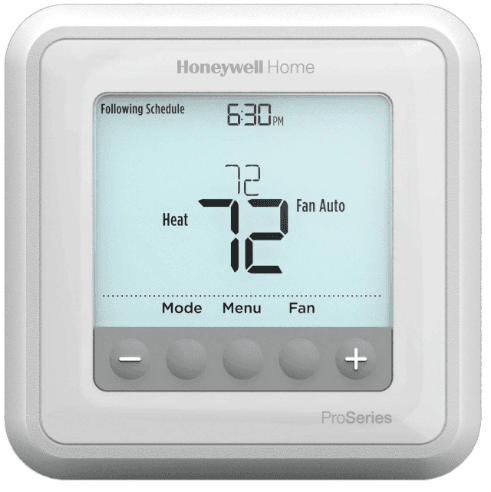
Optional Cover Plate installation
Use the Optional Cover Plate when:
- Mounting the thermostat to an electrical junction box
- Or when you need to cover paint gap from old thermostat.

- Separate the Junction Box Adapter from the Cover Plate. See Figure 1.
- Mount the Junction Box Adapter to the wall or an electrical box using any of the eight screw holes. Insert and tighten mounting screws supplied with Cover Plate Kit. Do not overtighten. See Figure 2. Make sure the Adapter Plate is level.

- Attach the UWP by hanging it on the top hook of the Junction Box Adapter and then snapping the bottom of the UWP in place. See Figure 3.
- Snap the Cover Plate onto the Junction Box Adapter. See Figure 4.
 UWP Mounting System installation
UWP Mounting System installation - Before starting, turn the power off at the breaker box or switch. Open package to find the UWP. See Figure 5.
- Position the UWP on wall. Level and mark hole positions. See Figure 6.
- Drill holes at marked positions, and then lightly tap supplied wall anchors into the wall using a hammer.
- Drill 7/32” holes for drywall.

- Pull the door open and insert the wires through wiring hole of the UWP. See Figure 7.
- Place the UWP over the wall anchors. Insert and tighten mounting screws supplied with the UWP. Do not overtighten. Tighten until the UWP no longer moves. Close the door. See Figure 8.

Power options
 Insert R and C wires into designated terminals for primary AC power (C terminal is optional if batteries are installed, but it is recommended). Remove wires by depressing the terminal tabs.
Insert R and C wires into designated terminals for primary AC power (C terminal is optional if batteries are installed, but it is recommended). Remove wires by depressing the terminal tabs.
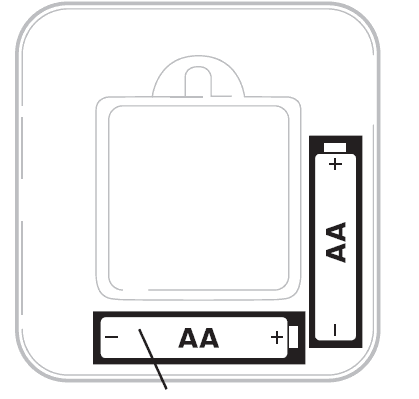
Insert AA batteries for primary or backup power.
Setting Slider Tabs
Set R Slider Tab
- Use built-in jumper (R Slider Tab) to differentiate between one or two transformer systems.
- If there is only one R wire, and it is connected to the R, RC, or RH terminal, set the slider to the up position (1 wire).
- If there is one wire connected to the R terminal and one wire connected to the Rc terminal, set the slider to the down position (2 wires).
UWP Mounting System
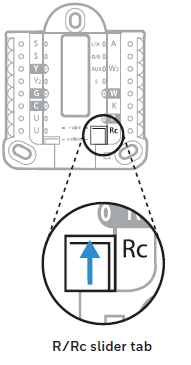
Wiring terminal designations
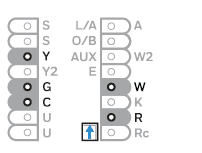
| S | Universal input for wired indoor or outdoor sensors | L/A – A | Heat Pump fault input (most common case) | |
| S | O/B | Changeover valve | ||
| Y | Compressor contactor (stage 1) | AUX – W2 | Auxiliary heat relay Heat relay (stage 2) | |
| Y2 | Compressor contactor (stage 2) | E | Emergency Heat relay | |
| G | Fan Relay | W | Heat relay (stage 1) | |
| C | 24VAC common. For 2 transformer systems, use common wire from cooling transformer. | K | Connect to K on Wire Saver Module** | |
| U |
Unused | R | 24VAC power from heating transformer* | |
| U | Rc | 24VAC power from cooling transformer* |
- Terminal can be jumped using Slider Tab. See “Setting Slider Tabs” above.
- The THP9045A1023 Wire Saver Module is used on heat/cool systems when you only have four wires at the thermostat, and you need a fifth wire for a common wire. Use the K terminal in place of the Y and G terminals on conventional or heat pump systems to provide control of the fan and the compressor through a single wire the unused wire then becomes your common wire. See THP9045 instructions for more information.
Wiring conventional systems: forced air and hydronics
- 1H/1C System (1 transformer)
- R Power [1]
- RC [R +RC joined by Slider Tab] [2]
- Y Compressor contactor
- C 24VAC common [3]
- W Heat relay
- G Fan relay
Heat-only System R Power [1]
- RC [R +RC joined by Slider Tab] [2]
- C 24VAC common [3]
- W Heat relay
Heat-only System (Series 20) [5]
- R Series 20 valve terminal “R” [1]
- RC [R +RC joined by Slider Tab] [2]
- Y Series 20 valve terminal “W”
- C 24VAC common [3]
- W Series 20 valve terminal “B”
Heat-only System
- (power open zone valve) [5]
- R Power [1]
- RC [R+ RC joined by Slider Tab] [2]
- W Valve
- C 24VAC common [3]
1H/1C System (2 transformers)
- R Power (heating transformer) [1]
- RC Power (cooling transformer) [1]
- Y Compressor contactor
- C 24VAC common [3, 4]
- W Heat relay
- G Fan relay
Heat-only System with Fan
- R Power [1]
- RC [R+ RC joined by Slider Tab] [2]
- C 24VAC common [3] W Heat relay
- G Fan relay
Cool-only System R Power [1]
- RC [R+ RC joined by Slider Tab] [2]
- Y Compressor contactor
- C 24VAC common [3]
- G Fan relay
2H/2C System (1 transformer) [6]
- R Power [1]
- RC [R+ RC joined by Slider Tab] [2] Y Compressor contactor (stage 1) C 24VAC common [3]
- W Heat relay (stage 1)
- G Fan relay
- W2 Heat relay (stage 2)
- Y2 Compressor contactor (stage 2)
Wiring heat pump systems
- 1H/1C Heat Pump System
- R Power [1]
- RC [R+RC joined by Slider Tab] [2]
- Y Compressor contactor C 24VAC common [3]
- O/B Changeover valve [7]
- G Fan relay
2H/1C Heat Pump System [8]
- R Power [1]
- RC [R+RC joined by Slider Tab] [2]
- Y Compressor contactor C 24VAC common [3]
- O/B Changeover valve [7]
- G Fan relay
- Aux Auxiliary heat
- E Emergency heat relay
- L Heat pump fault input
2H/2C Heat Pump System [9]
- R Power [1]
- RC [R+RC joined by Slider Tab] [2]
- Y Compressor contactor (stage 1)
- C 24VAC common [3]
- O/B Changeover valve [7] G Fan relay
- Y2 Compressor contactor (stage 2)
- L Heat pump fault input
3H/2C Heat Pump System
- (TH6320U only) [10]
- R Power [1]
- RC [R+RC joined by Slider Tab] [2]
- Y Compressor contactor (stage 1)
- C 24VAC common [3]
- O/B Changeover valve [7]
- G Fan relay
- Aux Auxiliary heat
- E Emergency heat relay
- Y2 Compressor contactor (stage 2)
- L Heat pump fault input
Dual Fuel System
- R Power [1]
- RC [R+RC joined by Slider Tab] [2]
- Y Compressor contactor (stage 1)
- C 24VAC common [3]
- O/B Changeover valve [7] G Fan relay
- Aux Auxiliary heat
- E Emergency heat relay
- Y2 Compressor contactor (stage 2 – if needed)
- L Heat pump fault input
- S Outdoor sensor
- S Outdoor sensor
Thermostat mounting
- Push excess wire back into the wall opening.
- Close the UWP door. It should remain closed without bulging.
- Align the UWP with the thermostat, and push gently until the thermostat snaps in place.
- Turn the power on at the breaker box or switch.

System operation settings
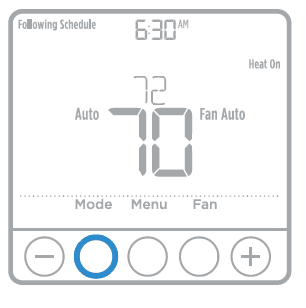
- Press the Mode button to cycle to the next available System mode.
- Cycle through the modes until the required System mode is displayed and leave it to activate.
System modes
- Auto
- Heat
- Cool
- EM Heat
- Off
Fan operation settings
- Press the Fan button to cycle to the next available Fan mode.
- Cycle through the modes until the required Fan mode is displayed and leave it to activate.

Fan modes
- Auto: Fan runs only when the heating or cooling system is on.
- On: Fan is always on.
- Circ: Fan runs randomly about 33% of the time.
Installer setup (ISU)
- Press and hold CENTER and buttons for approximately 3 seconds to enter advanced menu.
- Press Select to enter ISU.
- Press Select to cycle through menu setup options.
- Press or to change values or select from available options.
- Press Select and confirm your settings or press Back to ignore changes and return to ISU menu screen to continue editing another setup option.
- To finish setup process and save your setting, press Home and return to Home screen.

Advanced setup options (ISU)
| # ISU | ISU Name | ISU Options (factory default in bold) |
| 120 | Scheduling Options | 0 = Non-Programmable 2 = 5-2 Programmable 3 = 5-1-1 Programmable 4 = 7-Day Programmable |
| 125 | Temperature Indication Scale | 0 = Fahrenheit 1 = Celsius |
| 130 | Outdoor Sensor (TH6320 / TH6220 only) | 0 = None 1 = Wired Outdoor Sensor |
| 200 | Heating System Type | 1 = Conventional Forced Air Heat 2 = Heat Pump 3 = Radiant Heat 5 = None (Cool Only) |
| 205 | Heating Equipment Type | Conventional Forced Air Heat: 1 = Standard Efficiency Gas Forced Air 2 = High Efficiency Gas Forced Air 3 = Oil Forced Air 4 = Electric Forced Air 5 = Hot Water Fan Coil Heat Pump: 7 = Air to Air Heat Pump 8 = Geothermal Heat Pump Radiant Heat: 9 = Hot Water Radiant Heat 12 = Steam |
| 218 | Reversing Valve O/B | 0 = O (O/B in Cool) 1 = B (O/B in Heat) |
| 220 | Cool Stages / Compressor Stages 200=Conv / 200=HP (TH6320 / TH6220 only*) | 0, 1, 2* |
| # ISU | ISU Name | ISU Options (factory default in bold) | |
| 221 | Heat Stages / Backup Heat Stages | Heat Stages: 1, 2 Backup Heat Stages: 0, 1 | |
| 230 | Fan Control in Heat | 1 = Equipment Controls Fan 2 = Thermostat Controls Fan | |
| 253 | Aux/E terminal control (TH6320 only) | 0 = Drive both Aux & E together 1 = Aux and E independent | |
| 255 | Backup Heat Source (Heat Pump Only) | 1 = Electric Forced Air 2 = Gas/Oil Forced Air (or Fossil Forced Air) | |
| 256 | Emergency Heat Source (TH6320 only) | 1 = Electric Forced Air 2 = Gas/Oil Forced Air (or Fossil Forced Air) | |
| 260 | External Fossil Fuel Kit (TH6320 / TH6220 only) | 0 = Thermostat Controls Backup Heat 1 = External Fossil Fuel Kit Controls Backup Heat | |
| 270 | Backup Heat Fan | 1 = Equipment Controls Fan 2 = Thermostat Controls Fan Note: Setting only active with TH6320 in Heat Pump mode. | |
| 271 | Emergency Heat Fan | 1 = Equipment Controls Fan 2 = Thermostat Controls Fan Note: Setting only active with TH6320 in Heat Pump mode. | |
| 300 | System Changeover | 0 = Manual 1 = Automatic | |
| 303 | Auto Changeover Differential | 0 °F to 5 °F 0.0 °C to 2.5 °C Note: Differential is NOT deadland. Differential means how far past the setpoint before switching to the mode selected. Deadland setup is not an option. Honeywell uses an advanced algorithm that fixes deadland at 0 °F. This is more advanced than previous thermostats. | |
| 340 | Backup Heat Droop | 0 = Comfort 2 = 2 °F 3 = 3 °F 4 = 4 °F 5 = 5 °F 6 = 6 °F 7 = 7 °F 8 = 8 °F | 9 = 9 °F 10 = 10 °F 11 = 11 °F 12 = 12 °F 13 = 13 °F 14 = 14 °F 15 = 15 °F |
| 350 | Upstage Timer for Backup Heat | 0 = Off 1 = 30 minutes 2 = 45 minutes 3 = 60 minutes 4 = 75 minutes 5 = 90 minutes 6 = 2 hours 7 = 3 hours 8 = 4 hours 10 = 5 hours | |
| 355 | Compressor Lockout / Balance Point | — = Off 5 °F to 60 °F (in 5 °F increments) -15.0 °C to 15.5 °C (in 2.5 °C or 3.0 °C increments) Note: Use a wired sensor to set compressor lockout / balance point on TH6320 / TH6220. | |
| 356 | Outdoor Lockout Backup Heat | — = Off 5 °F to 65 °F (in 5 °F increments) -15.0 °C to 18.5 °C (in 2.5 °C or 3.0 °C increments) | |
| 365 | Compressor Cycle Rate (Stage 1) | 1 – 6 | |
| 366 | Compressor Cycle Rate (Stage 1) | 1 – 6 | |
| 370 | Heating Cycle Rate (Stage 1) | 1 – 12 | |
| 371 | Heating Cycle Rate (Stage 2) | 1 – 12 | |
| # ISU | ISU Name | ISU Options (factory default in bold) | |
| 375 | Heating Cycle Rate Auxiliary Heat | 1 – 12 | |
| 378 | Heating Cycle Rate Emergency Heat (TH6320 only) | 1 – 12 | |
| 387 | Compressor Protection | 0 = Off 1 – 5 minutes | |
| 425 | Adaptive Intelligent Recovery | 0 = No 1 = Yes Note: Adaptive Intelligent Recovery (AIR) is a comfort setting. Heating or cooling equipment will turn on earlier, ensuring the indoor temperature will match the setpoint at the scheduled time. | |
| 430 | Minimum Cool Setpoint | 50 °F to 99 °F (50 °F) 10.0 °C to 37.0 °C (10.0 °C) | |
| 431 | Maximum Heat Setpoint | 40 °F to 90 °F (90 °F) 4.5 °C to 32.0 °C (32.2 °C) | |
| 435 | Keypad Lockout | 0 = None 1 = Partial 2 = Full | |
| 500 | Is Indoor Temperature Sensor WIRED to your system? (TH6320 / TH6220 only) | 0 = No 1 = Yes | |
| 515 | Indoor Sensor type (TH6320 / TH6220 only) | 0 = 10k 1 = 20k | |
| 520 | Which Sensors will be used for TEMPERATURE Control? (Multiple Sensors are Averaged) (TH6320 / TH6220 only) | 1 = Thermostat Only 2 = Wired Only 3 = Average | |
| 702 | Number of Air Filters | 0 – 2 | |
| 711 | Air Filter 1 Replacement Reminder | 0 = Off 1 = 10 Run Time Days 2 = 20 Run Time Days 3 = 30 Run Time Days 4 = 45 Run Time Days 5 = 60 Run Time Days 6 = 90 Run Time Days 7 = 120 Run Time Days 8 = 150 Run Time Days 9 = 30 Calendar Days | 10 = 45 Calendar Days 11 = 60 Calendar Days 12 = 75 Calendar Days 13 = 3 Calendar Months 14 = 4 Calendar Months 15 = 5 Calendar Months 16 = 6 Calendar Months 17 = 9 Calendar Months 18 = 12 Calendar Months 19 = 15 Calendar Months |
| 712 | Air Filter 2 Replacement Reminder | 0 = Off 1 = 10 Run Time Days 2 = 20 Run Time Days 3 = 30 Run Time Days 4 = 45 Run Time Days 5 = 60 Run Time Days 6= 90 Run Time Days 7 = 120 Run Time Days 8 = 150 Run Time Days 9 = 30 Calendar Days | 10 = 45 Calendar Days 11 = 60 Calendar Days 12 = 75 Calendar Days 13 = 3 Calendar Months 14 = 4 Calendar Months 15 = 5 Calendar Months 16 = 6 Calendar Months 17 = 9 Calendar Months 18 = 12 Calendar Months 19 = 15 Calendar Months |
| 1400 | Backlighting | 0 = On Demand 1 = Continuous Note: Common wire needed for continuous. | |
| 1401 | Backlight brightness | 1 – 5 Note: Only displayed if continuous backlight selected. | |
| 1410 | Clock Format | 12 / 24 | |
| 1415 | Daylight Saving Time | 0 = Off 1 = On | |
| 1420 | Temperature Display Offset | -3 to 3F (0) -1.5 to 1.5C (0) | |
Installer system test
To perform a System Test:
- Press and hold CENTER and + buttons for approximately 3 seconds to enter advanced menu.
- Use + to go to TEST. Press Select to enter System Test.
- Use + to change between Heat, Cool, Fan, EM Heat, or Ver (thermostat version information). Press Select.
- Press+ to turn stages on one at a time, and press_ to turn them off.
- Use the Home button to exit the System Test.

| System test | System status | |
| Shaded areas below apply only to TH6320U/TH6220U or as otherwise noted. | ||
| 0 | All Off | |
| 1 | Heat Stage 1 on | |
| Heat | ||
| 2 | Heat Stage 2 also on | |
| 3 | Heat Stage 3 also on | |
| 0 | All Off | |
| Cool | 1 | Cool Stage 1 on |
| 2 | Cool Stage 2 also on | |
| 0 | All Off | |
| Em Heat | ||
| 1 | Em Heat on | |
| 0 | Fan Off | |
| Fan | ||
| 1 | Fan On | |
Specifications
Temperature Ranges
Heat: 40 °F to 90 °F (4.5 °C to 32.0 °C)
Cool: 50 °F to 99 °F (10.0 °C to 37.0 °C)
Working Ambient Temperature
32 °F to 120 °F (0 C° to 48.9 °C)
Operating Ambient Temperature
37 °F to 102 °F (2.8 °C to 38.9 °C)
Shipping Temperature
-20 °F to 120 °F (-28.9 °C to 48.9 °C)
Operating Relative Humidity
5% to 90% (non-condensing)
Physical Dimensions in inches (mm) (H x W x D)
4-1/16” H x 4-1/16” W x 1-5/32” D
103.5 mm H x 103.5 mm W x 29 mm D
Electrical Ratings
| Terminal | Voltage (50/60Hz) | Running Current |
| W Heating | 20-30 Vac | 0.02-1.0 A |
| (Powerpile) | 750 mV DC | 100 mA DC |
| W2 (Aux) Heating | 20-30 Vac | 0.02-1.0 A |
| E Emergency Heat | 20-30 Vac | 0.02-0.5 A |
| Y Compressor Stage 1 | 20-30 Vac | 0.02-1.0 A |
| Y2 Compressor Stage 2 | 20-30 Vac | 0.02-1.0 A |
| G Fan | 20-30 Vac | 0.02-0.5 A |
| O/B Changeover | 20-30 Vac | 0.02-0.5 A |
| L/A Input | 20-30 Vac | 0.02-0.5 A |
Customer assistance
For assistance with this product, please visit customer.honeywell.com. Or call Honeywell Customer Care toll-free at 1-800-468-1502.
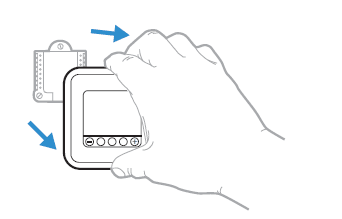 Pull to remove the thermostat from the UWP.
Pull to remove the thermostat from the UWP.
For more manuals by Honeywell visit, ManualsLibraryy
Honeywell T6 Pro Programmable Thermostat-FAQs
What is the temperature offset on a Honeywell T6 Pro thermostat?
The temperature offset on the Honeywell T6 Pro thermostat can be adjusted between -1.5°C and +1.5°C in increments of 0.5°C.
What is the best setting for your thermostat?
For optimal comfort and energy efficiency, it’s recommended to set your thermostat between 70°F and 78°F (21°C to 26°C) in warmer months and lower the temperature during colder months.
How can I determine which Honeywell thermostat I have?
The model number is typically found on the back of the detachable faceplate of your thermostat. You can also find it on the product packaging or in the included documentation.
Does the Honeywell T6 Pro have an auto mode?
Yes, the Honeywell T6 Pro has an auto mode that allows the thermostat to automatically switch between heating or cooling to maintain the desired temperature. It also has “Em Heat” for auxiliary or emergency heat when using a heat pump system.
How does the Honeywell thermostat measure temperature?
The Honeywell thermostat takes both the ambient air temperature and the radiant temperature of objects in the room into account to provide a more accurate and human-like temperature reading.
Why is my Honeywell T6 Pro thermostat showing “Heat On” flashing?
If “Heat On” is flashing, the thermostat is in a five-minute delay mode to prevent short cycling and potential damage to your system. This delay happens if the power is recently interrupted.
How can I stop my thermostat from changing temperature?
To prevent your thermostat from changing the temperature, press the ‘Hold’ button after adjusting it to your desired setting. This will lock the temperature until you manually adjust it again.
How do I set temperature limits on the Honeywell T6 Pro?
To set limits, navigate to the “Heat Range” option using the arrow buttons. You can then adjust the lower and upper temperature limits from 5°C to 21°C (min) and 21°C to 35°C (max).
How do I change my Honeywell T6 Pro to Celsius?
To switch to Celsius, press the Menu button, navigate to F / C, and press Select. Then, choose between Fahrenheit (F) or Celsius (C).
What is Honeywell Eco Mode?
Eco Mode allows you to set a lower, energy-saving temperature for a specific period. It is designed to help minimize energy use while maintaining comfort in your home.
What is the “Dry Mode” on a Honeywell thermostat?
Dry Mode is a setting on some Honeywell thermostats and air conditioning units that reduces humidity levels in your home without significantly lowering the temperature. It’s ideal for humid conditions.

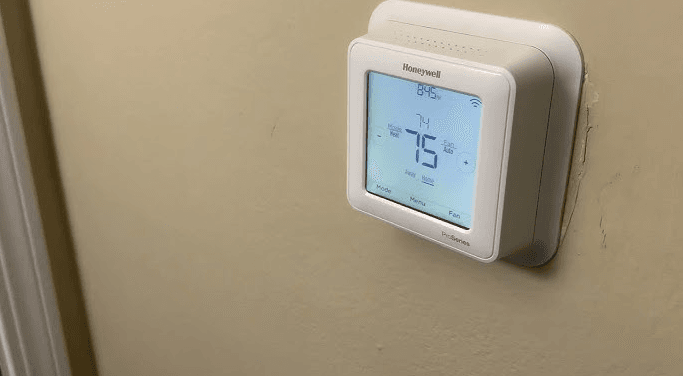
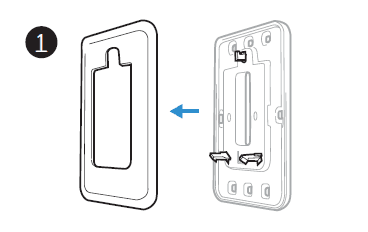
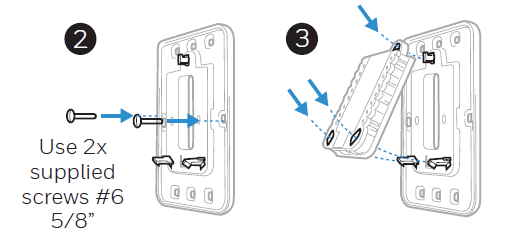
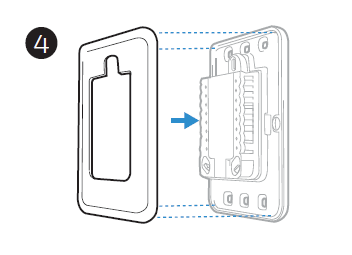 UWP Mounting System installation
UWP Mounting System installation